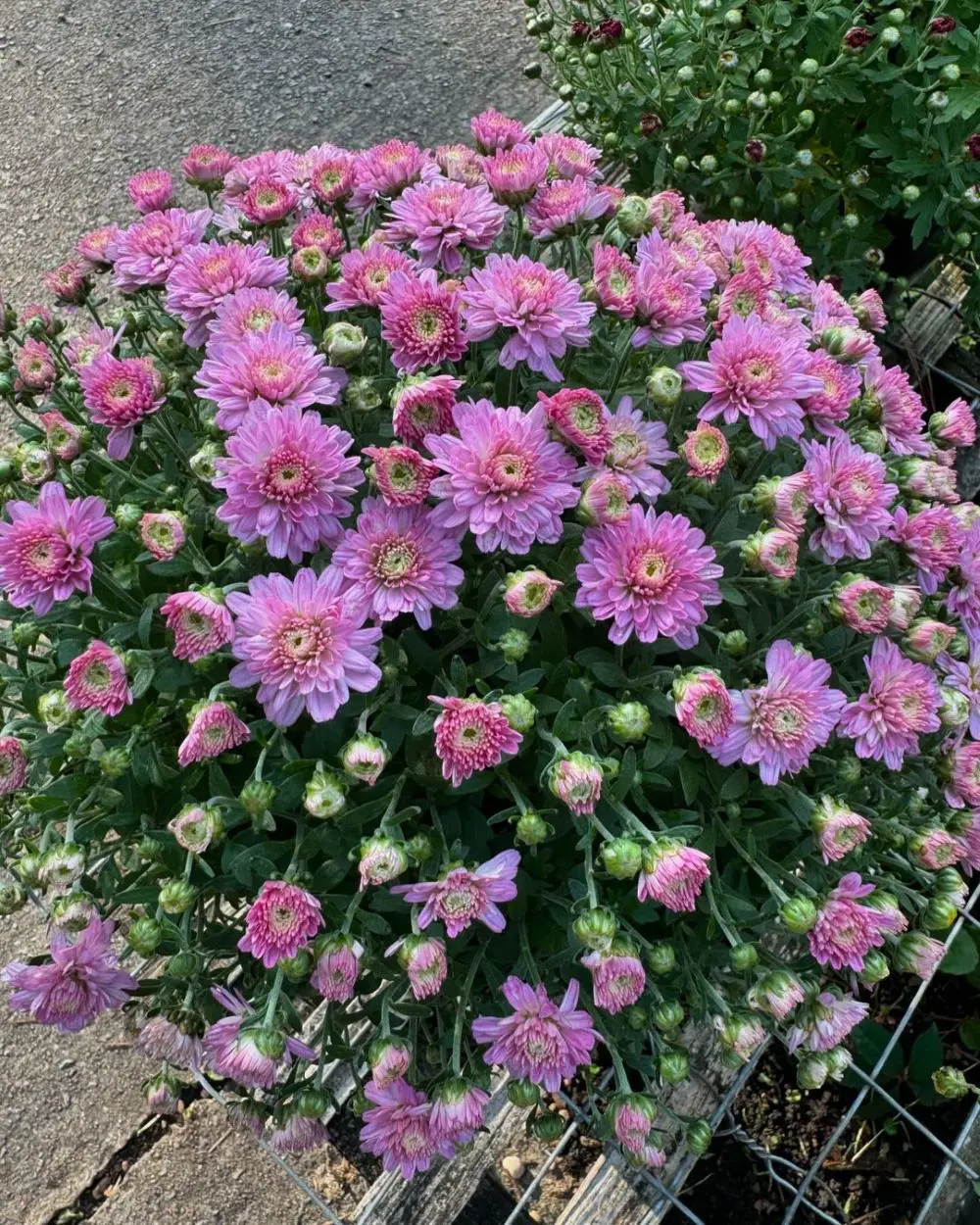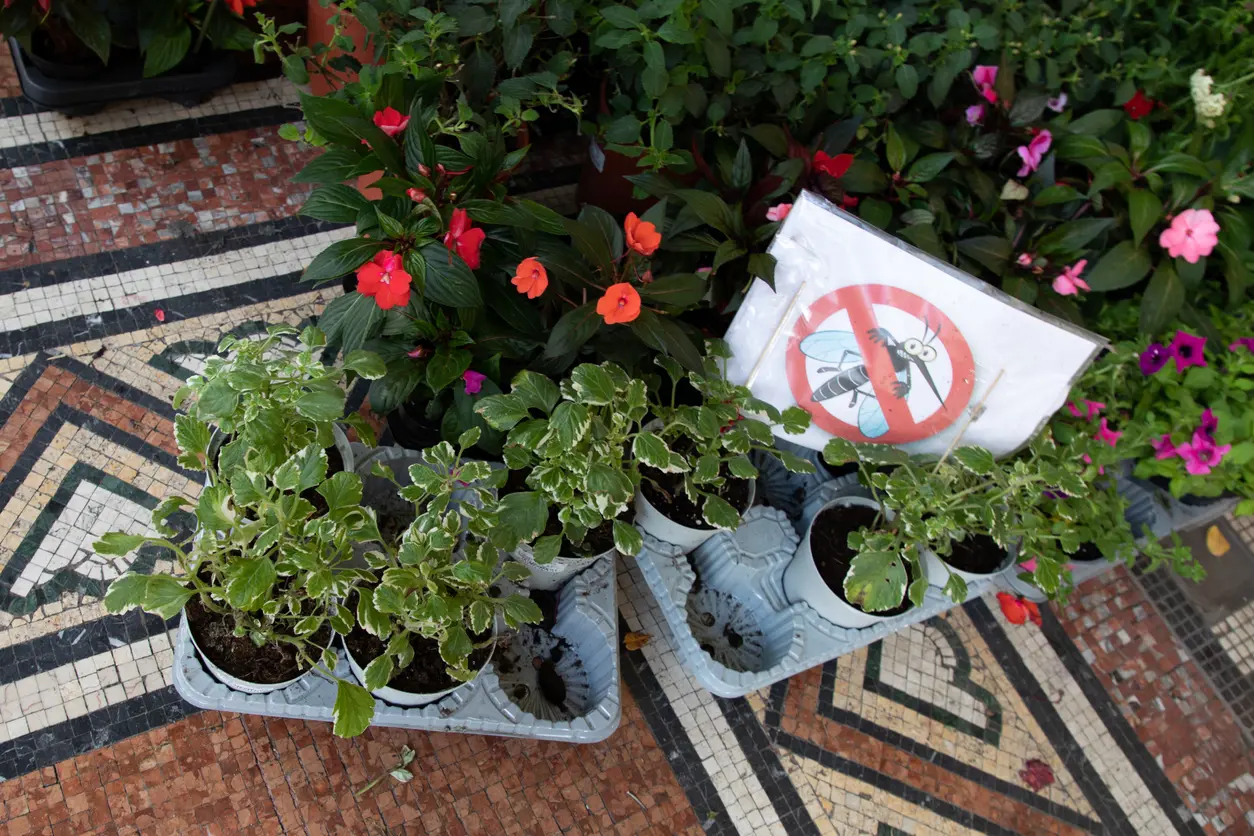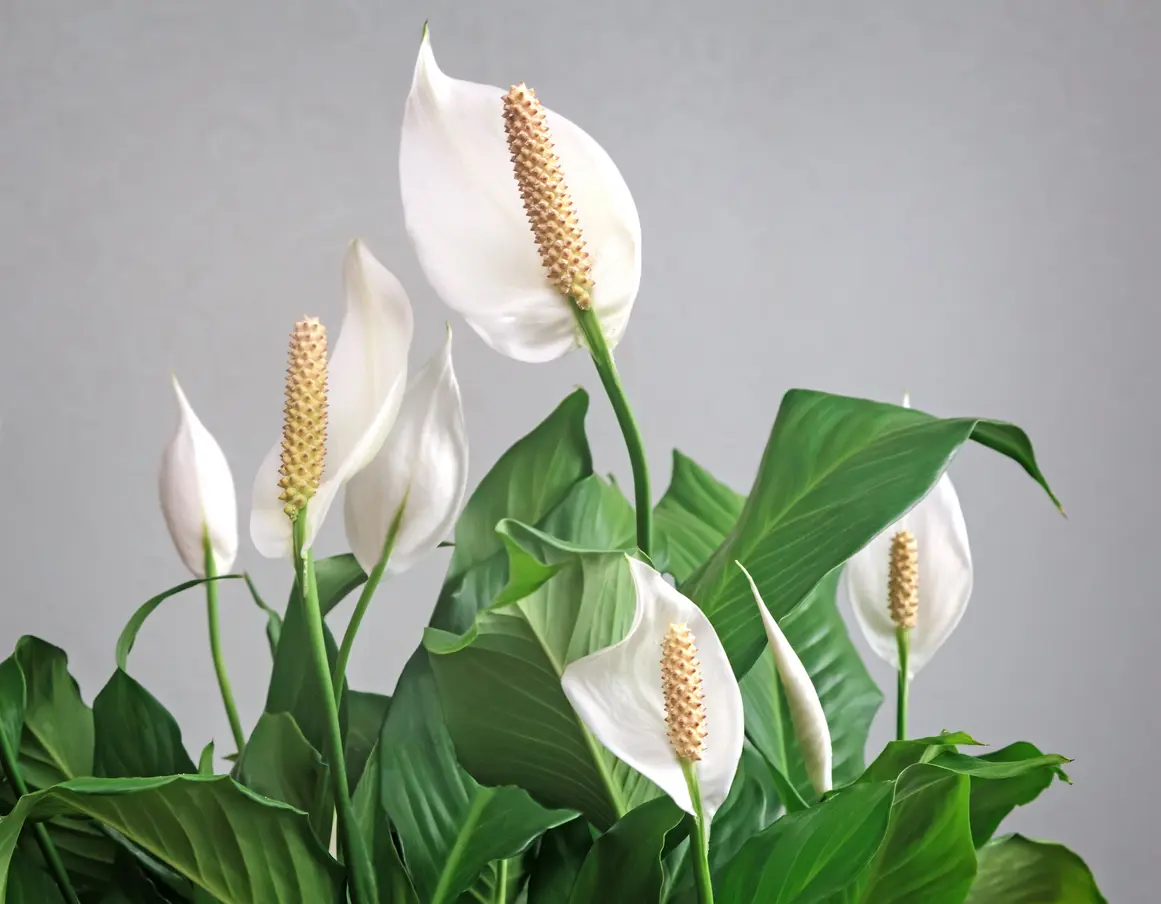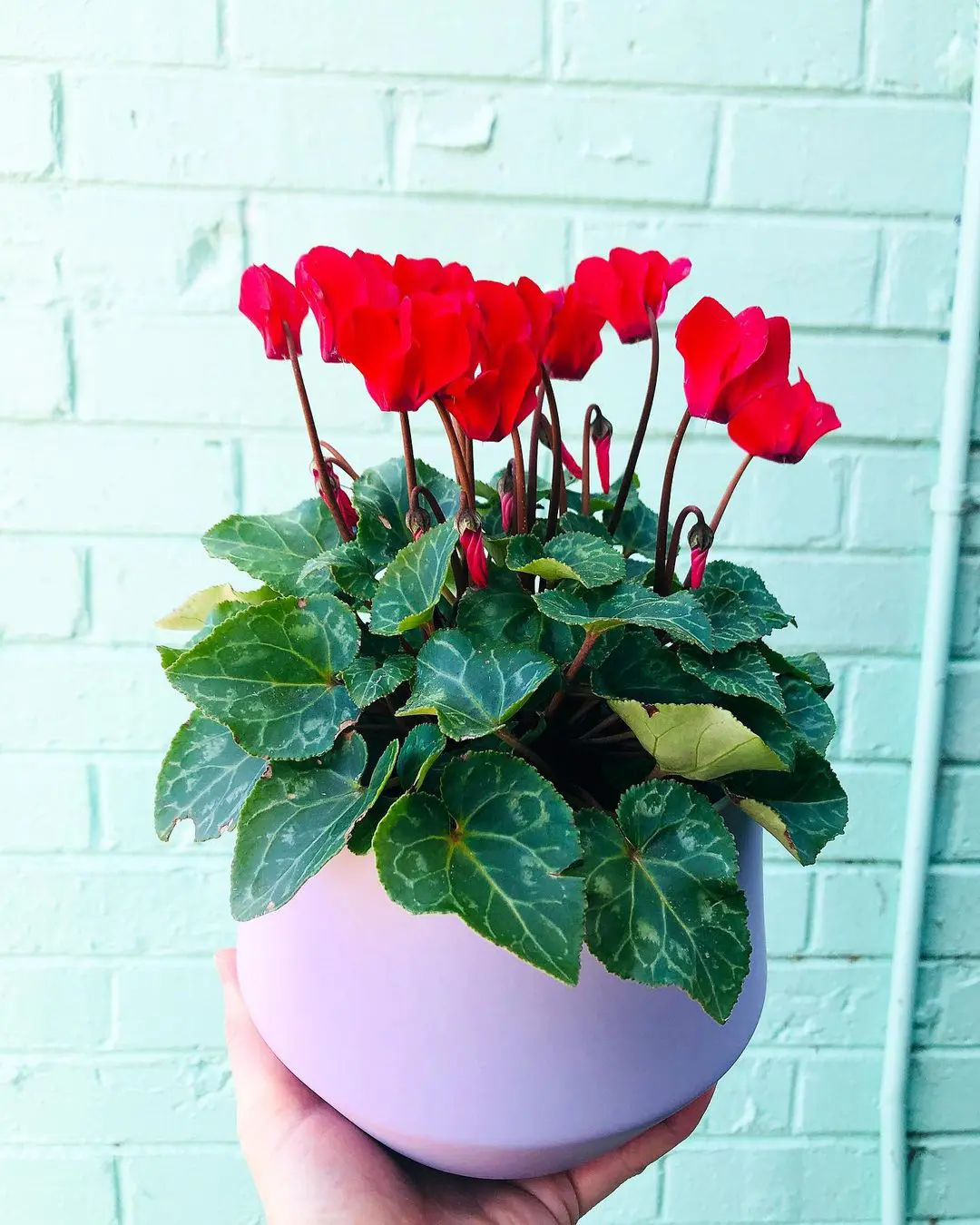
Cyclamen are beautiful flowering plants that are popular as indoor houseplants. They are known for their delicate, star-shaped flowers and their marbled leaves.
These plants are native to the Mediterranean and Middle Eastern regions, and they prefer cool temperatures and moist soil. With proper care, cyclamen can bloom for several months.
This guide will provide you with everything you need to know about growing, watering, and fertilizing cyclamen plants. We will cover topics such as choosing the right outdoor or indoor plant, providing the proper light, watering correctly, and fertilizing for optimal growth and flowering.
Cyclamen Care
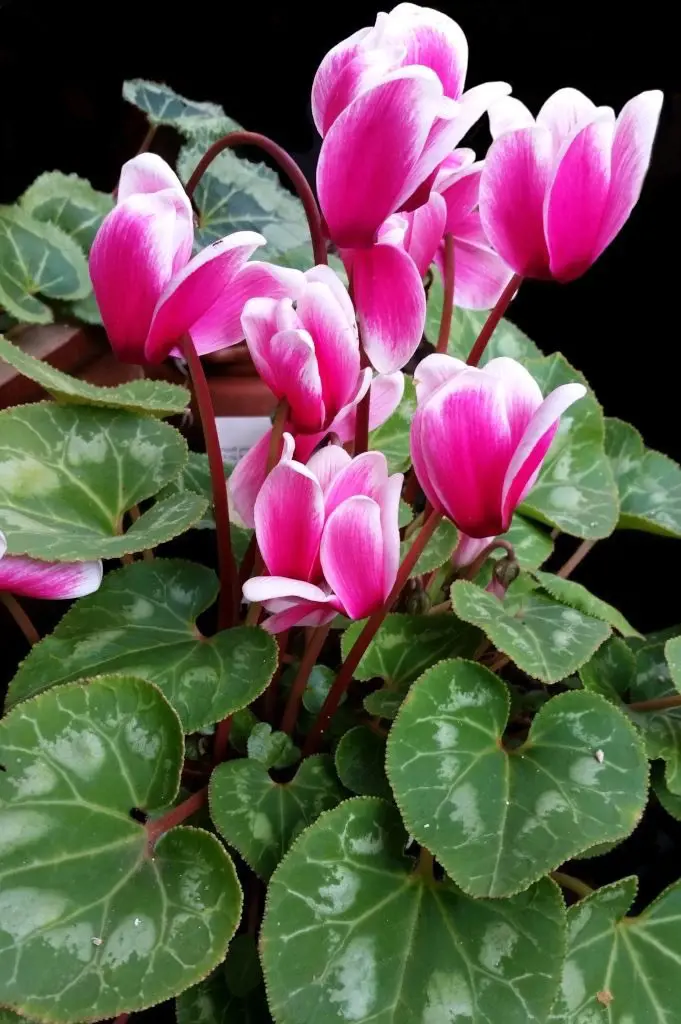
Cyclamen's vibrant blooms and unique foliage add charm to any garden. But these delicate beauties have particular needs! Fear not, plant lovers! This guide unlocks their secrets:
- Light: Bathe your cyclamen in bright, indirect sunlight. Think mornings on a north-facing windowsill. Harsh rays scorch its delicate leaves.
- Watering: Think "moist, not soggy." Water deeply when the top inch of soil feels dry, letting excess drain away. Bottom watering is best to avoid crown rot.
- Temperature: Imagine a cool mountain breeze. Aim for 60-65°F (15-18°C). Avoid drafts and heat sources like radiators.
- Food: During bloom, feed a weak liquid fertilizer every 2 weeks. Once blooms fade, stop feeding and gradually reduce watering as the plant enters dormancy.
Now it's time to delve into these points in detail!
Sunlight Requirements

Cyclamen crave bright, indirect sunlight, like dappled forest light. Avoid the harsh direct sun at all costs, which can scorch leaves and shorten blooms.
- Outdoors: Seek sheltered spots under trees or shade cloth, especially during summer's peak heat.
- Indoors: Place it near an east or north-facing window. South-facing windows might need sheer curtains for midday shade.
Cyclamen lovers need to know that this plant is a cool-loving creature. While they adore light, excessive heat can trigger dormancy. Keep them away from radiators and drafty areas.
Ideal Temperature for Your Cyclamen

Unlike many houseplants, cyclamen plants crave coolness! They're not fans of tropical vibes. They thrive in temperatures mimicking their mountainside origins.
Aim for daytime temperatures between 60-65°F (15-18°C) and nighttime dips around 50°F (10°C). This will give similarity to their Mediterranean mountain home. Too hot? Expect bud woes and early dormancy.
Moreover, avoid heat sources like radiators and drafts. Keep your cyclamen happy and blooming by providing a refreshingly crisp environment!
Choosing the Perfect Soil
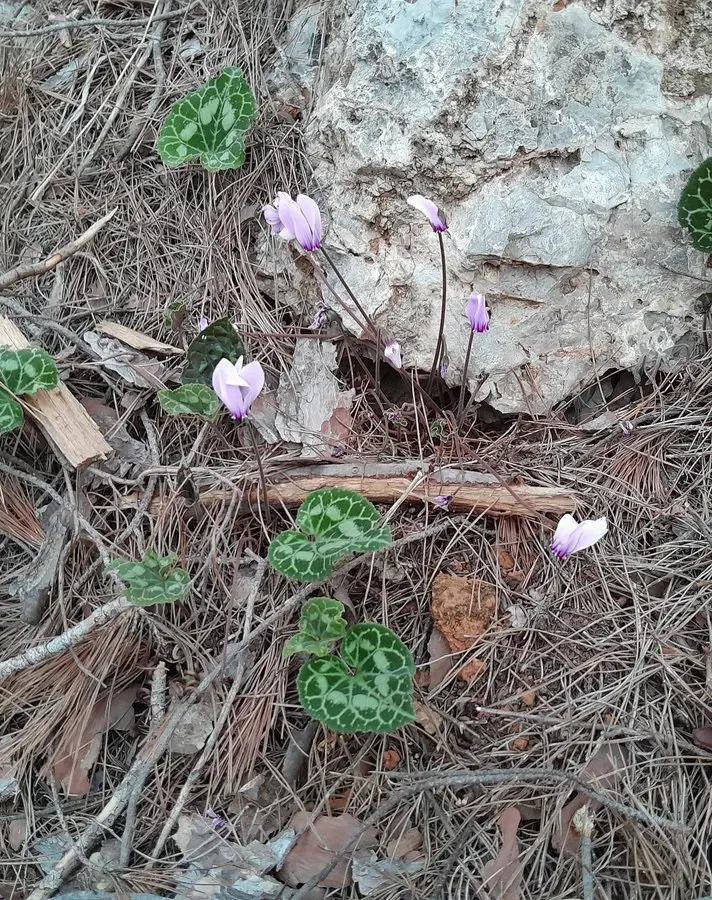
Cyclamen, with their delicate blooms and marbled leaves, add a touch of charm to any garden. But to ensure these beauties thrive, picking the right soil is crucial. Here's a quick guide:
- Drainage: Avoid waterlogged soil, as it can lead to root rot. Opt for sandy loam or loamy soil amended with compost or perlite for better drainage.
- Nutrients: Mix in aged compost or a balanced fertilizer to provide essential nutrients for healthy growth and vibrant blooms.
- Acidity: Cyclamen prefer slightly acidic to neutral soil (pH 6.0-7.0). If your soil is too alkaline, you can add peat moss or coffee grounds to lower the pH.
Master the Art of Placement and Container Care
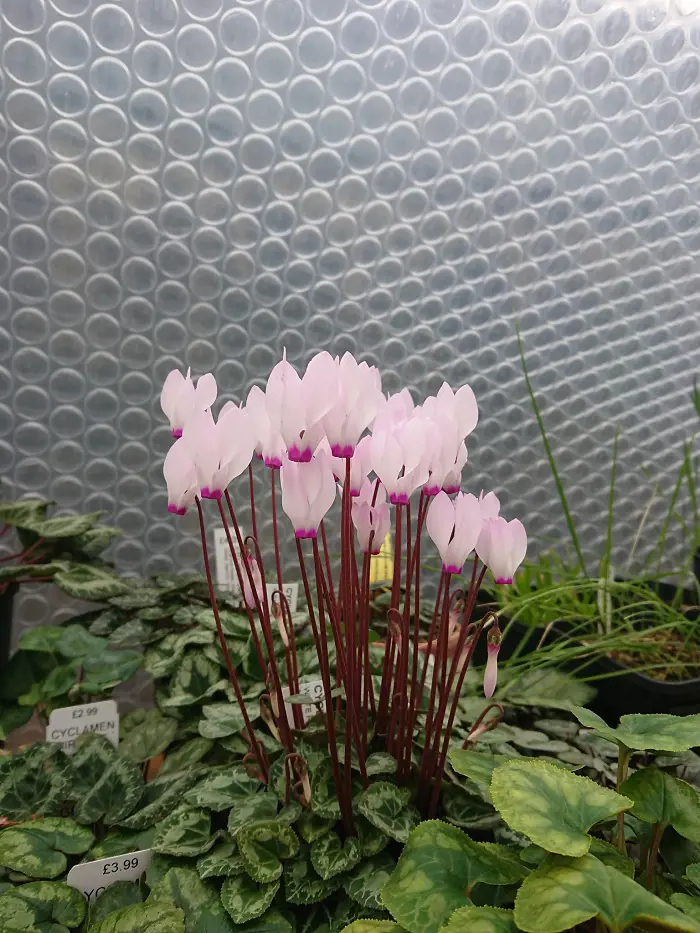
These charming flower-bearers add a touch of elegance to any space. But before their vibrant blooms grace your home, ensure a happy life with the right planting and container care.
Choose for well-draining pots and soil, mimicking their woodland haven. Nestle the tubers gently, leaving the "crown" exposed. Indirect, bright light is their sweet spot, while cool temperatures keep them thriving.
Watering is integral, but avoid drenching the tuber - aim for the soil base. Let them dry slightly between sips. Feed lightly during blooming, and soon, you'll be rewarded with a beautiful display!
Watering Your Cyclamen
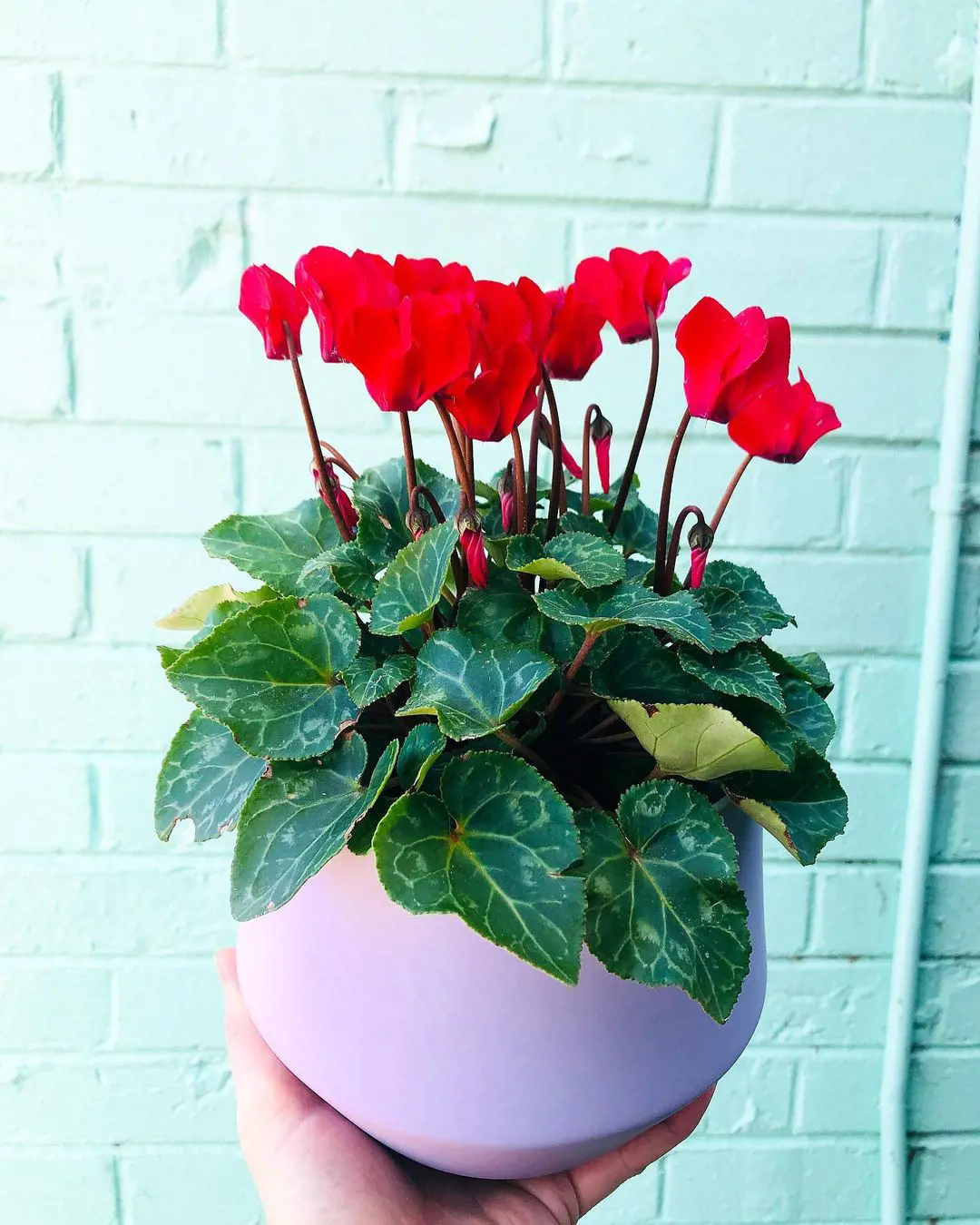
Cyclamen crave moisture, but overwatering means disaster! Learn the delicate art of keeping your cyclamen happy:
- Check often: Feel the soil inch-deep - water only when dry. Overwatering rots the tuber!
- Bottom-up best: Avoid pouring from above, which risks crown rot. Place the pot in a tray of water, letting it soak till moist, then drain excess.
- Frequency flexes: Water more during active growth and blooming, less when dormant (summer). Droopy leaves signal thirst, yellowing means overwatering.
- Goodbye, hard water: You should aim for filtered or rainwater.
- Tepid is ideal: Utilize room-temperature water to avoid stressing the plant.
Types of Fertilizers for Cylamen

A Cyclamen plant thrives with appropriate fertilization. The three major types of fertilizers cater to their needs: balanced, water-soluble, and slow-release.
A balanced fertilizer with equal nitrogen, phosphorus, and potassium will aid in promoting overall growth. Water-soluble options are convenient for regular feeding, ensuring essential nutrients reach the roots.
Slow-release fertilizers offer a steady nutrient supply over an extended period, reducing the frequency of application.
Knowing the specific requirements of your cyclamen plant allows for tailored fertilization, fostering healthy foliage and vibrant blooms throughout the growing season.
Fertilizer Feeding Schedule
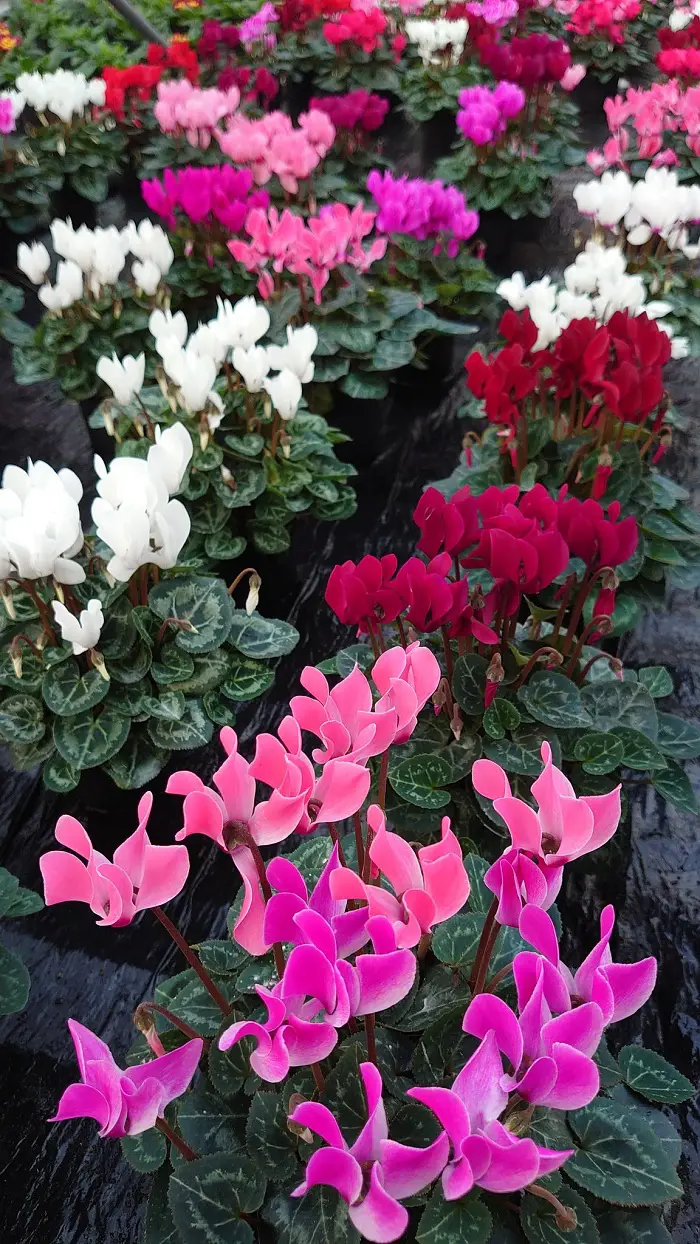
Creating a well-tailored feeding schedule is integral for the flourishing of Cyclamen plants. During the active growing season, you need to apply a balanced fertilizer every 4-6 weeks, adjusting the frequency based on the plant's response.
Water-soluble fertilizers could be incorporated into regular watering routines, ensuring a consistent nutrient supply. In the dormant phase, reduce fertilization to once every 8-10 weeks.
It's important to follow package instructions and avoid over-fertilization. A mindful feeding regimen supports the Cyclamen's health, encouraging robust foliage, and vibrant, long-lasting star blooms.
Spoil Your Cyclamen with Mulch

While cyclamen crave well-draining soil, they appreciate a cool and moist environment around their roots. Enter mulch, your plant's natural guardian!
Benefits of Mulching:
- Increases Moisture: Mulch acts as a sponge, retaining moisture and decreasing the frequent watering needs.
- Temperature Tamer: It insulates the soil, keeping roots cool in summer and warm in winter.
- Weed Warrior: Mulch suppresses pesky weeds, saving you effort and time.
- Nutrient Booster: As it decomposes, mulch adds organic matter to the soil, feeding your cyclamen naturally.
Pruning for Health and Happiness

Cyclamen don't require extensive pruning, but strategic trims can keep them looking neat and encourage more blooms. Here's your guide:
- Leaf Removal: Remove yellow, wilted, or diseased leaves close to the stem. This improves air circulation and prevents the spread of problems.
- Deadheading: As these flowers fade, snip them off at the base with sharp, clean pruners. This prevents seed formation and redirects energy to new growth.
- Post-Bloom Pruning: After flowering finishes, cut flower stems and remaining leaves to an inch above the tuber. This encourages dormancy and next year's blooms.
Remember to use sterilized pruners to avoid introducing diseases. Also, don't prune excessively, as it can stress the plant.
Deadheading Your Cyclamen
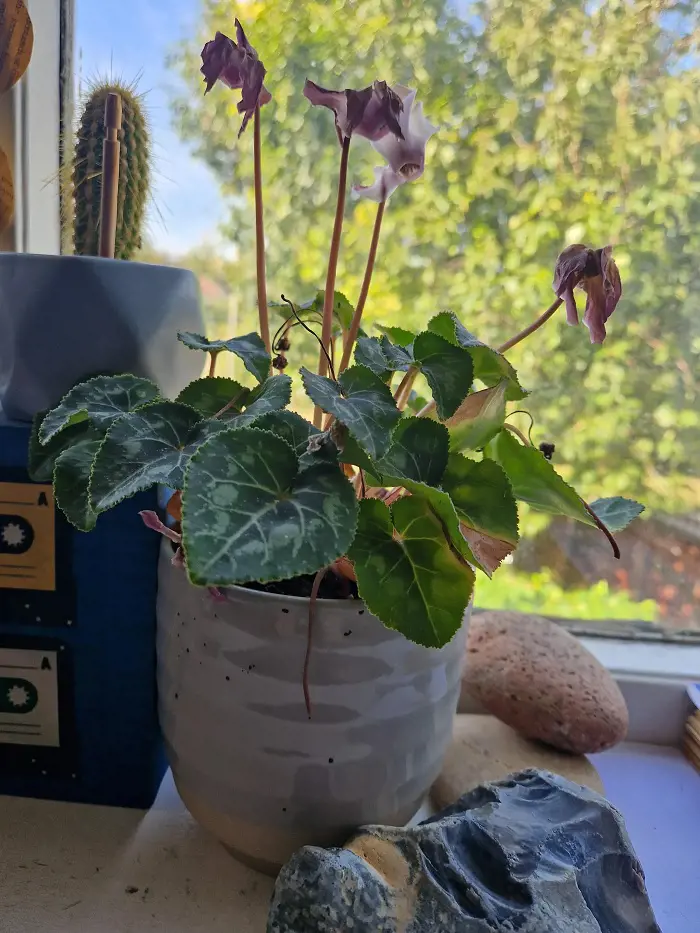
Deadheading is crucial for maintaining cyclamen's vitality. Gently removing faded or spent flowers prevents seed formation, redirecting the plant's energy towards new growth and blossoms.
You can employ clean, sharp scissors or shears to snip the wilted blooms at the base of their stems. This process not only elevates the plant's aesthetic appeal but also encourages prolonged flowering.
Regular deadheading, especially during the blooming season, ensures a continuous display of vibrant, healthy flowers and supports the overall well-being of your cyclamen plant.
Caring for Cyclamen Post-Bloom

Optimal cyclamen care during dormancy ensures robust future blooms. When flowering ceases, reduce watering gradually, allowing the plant to enter a resting phase.
You should trim yellow or withered leaves but leave healthy ones to support regeneration. Move the plant to a cool, dark location for about 2-3 months, allowing it to recharge.
Avoid overwatering during this period. Once new growth emerges, resume regular care with a gradual return to a well-lit location, initiating another cycle of vibrant cyclamen blossoms.
Bringing Your Cyclamen Back to Bloom
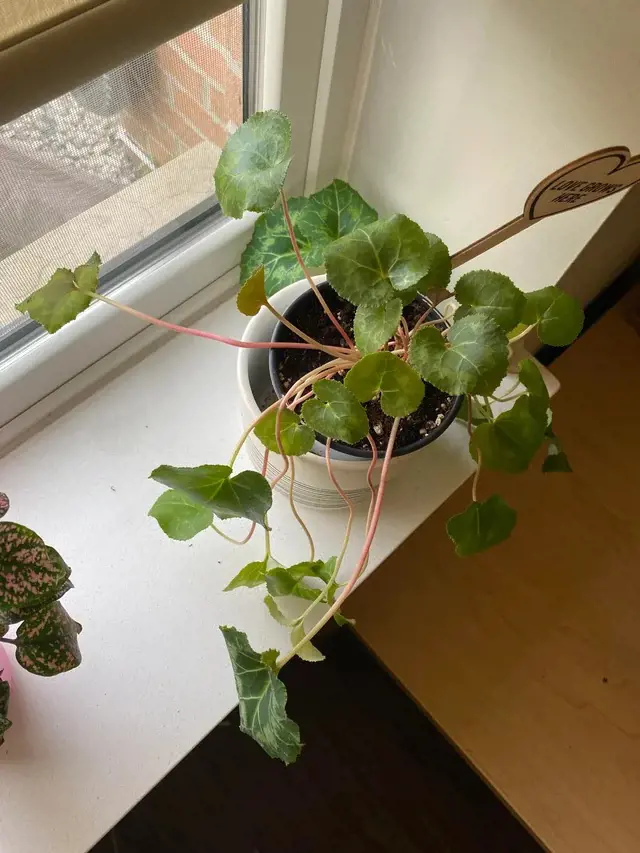
Cyclamen's vibrant flowers are a winter delight, but what about next year? Here's the secret to reblooming your beauty:
- Rest & Rejuvenate: After blooms fade (late spring), gradually reduce watering and stop fertilizing.
- Dormant Dreams: Move your cyclamen to a cool, shady spot for summer. Water very sparingly to prevent shriveling.
- Wake Up Call: Come fall, bring it back to bright, indirect light. You can repot in fresh, well-draining soil.
- Thirsty for Success: Slowly resume watering, maintaining the soil moist but not soggy.
- Food for Flowers: Start feeding with a balanced houseplant fertilizer every 2-3 weeks.
Multiply Your Cyclamen: Propagation Options
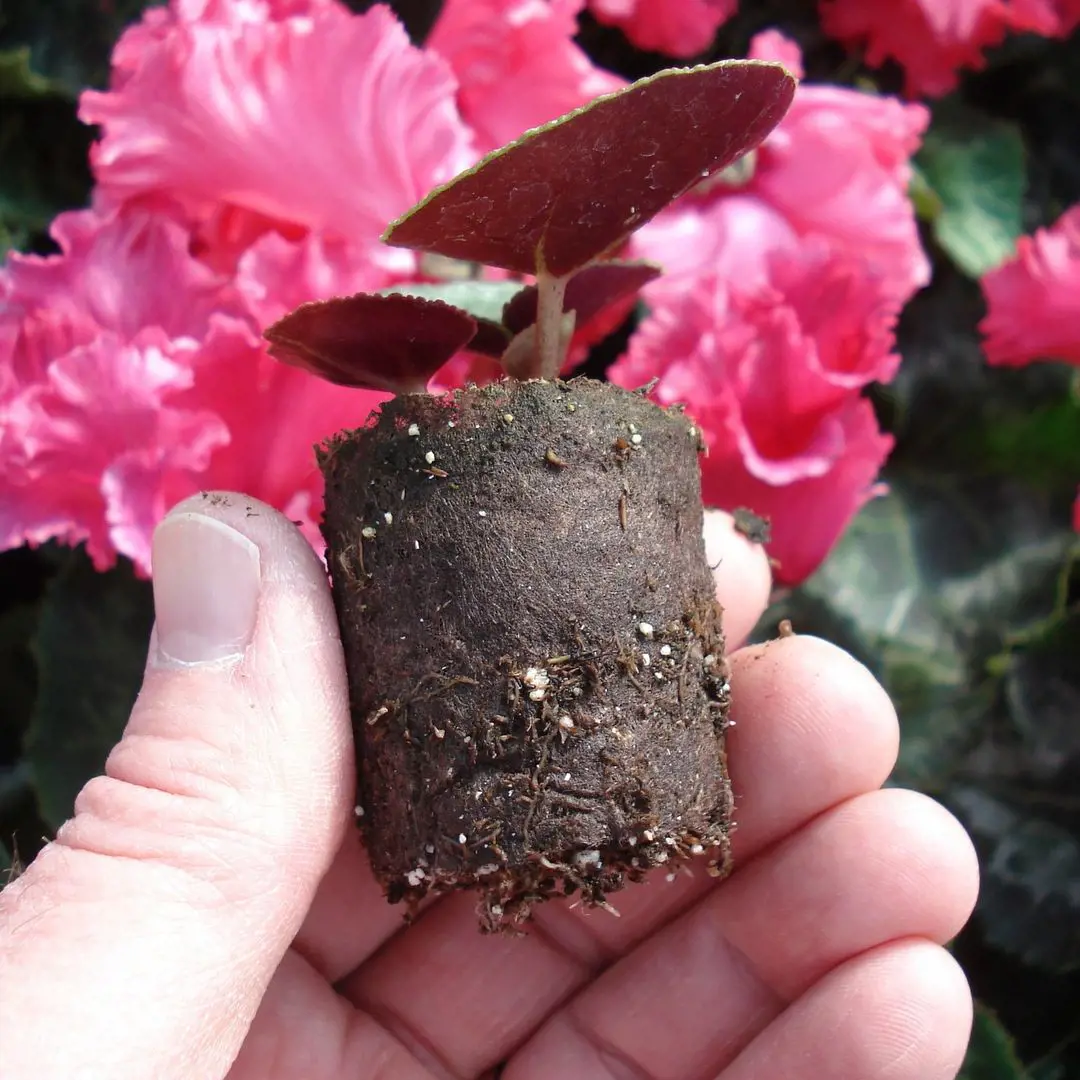
Cyclamen's charm is contagious! Here are two ways to create new plantlets:
- Seedlings: For patient gardeners out there, collect ripe seeds, soak them overnight, and sow in a cool, moist seed tray. Germination takes time, but the reward is unique, personalized blooms.
- Division: This method is faster. In the fall, gently lift the tuber, cut it into sections with "eyes" (growing points), and replant each piece. Provide light, warmth, and moisture - new cyclamen are on their way!
Both these methods need patience and specific care. Research your chosen method and tailor it to your cyclamen variety for success. Happy propagating!
When to Plant Cyclamen?
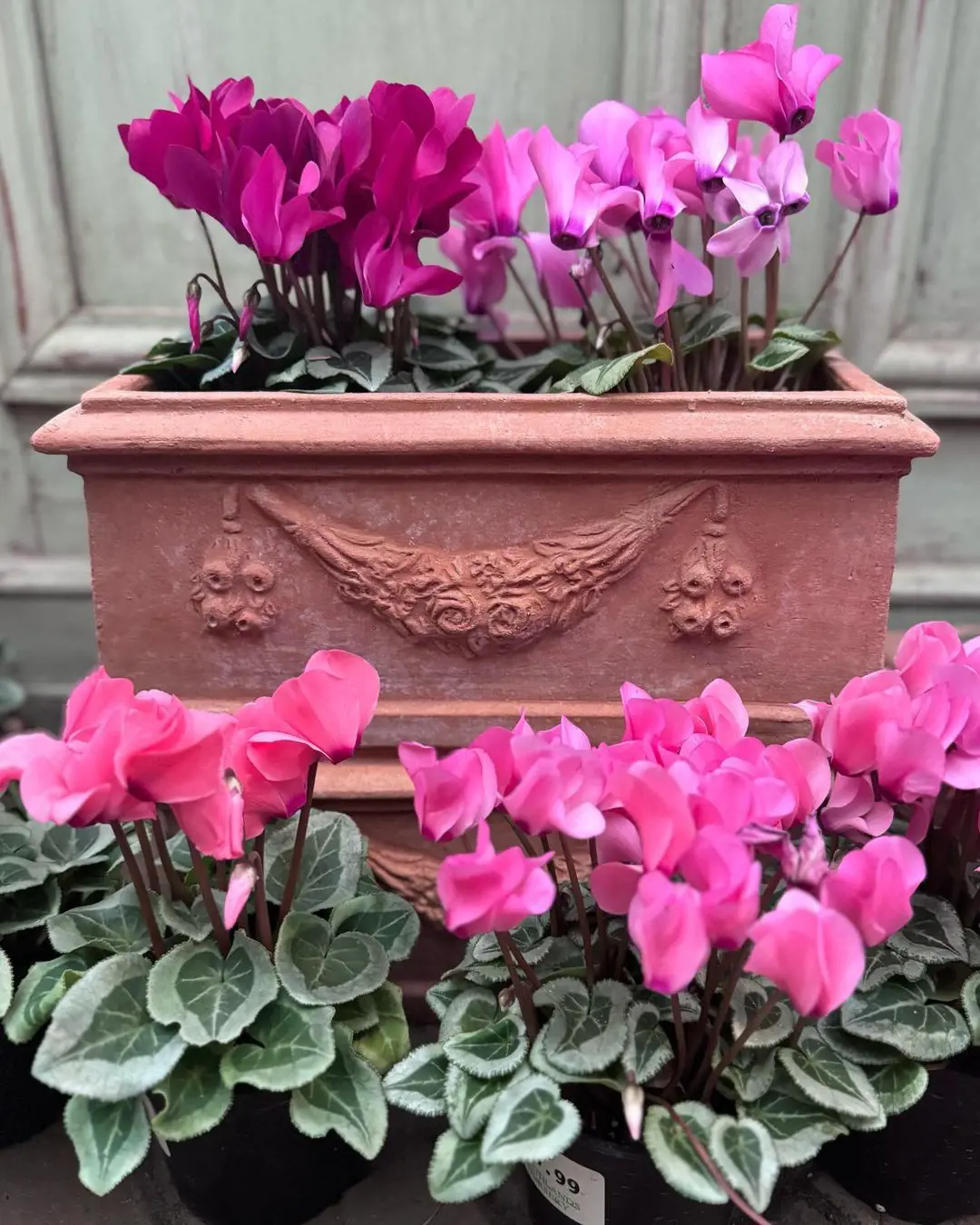
Plant cyclamen tubers in late summer to early autumn for a spectacular winter and spring display. These hardy perennials prefer cooler temperatures, establishing robust root systems before winter dormancy.
Choose a location with well-draining soil and partial shade, as direct sunlight can scorch their delicate foliage. Ensure the tubers are planted just below the soil surface.
Early planting allows cyclamen to acclimate to their environment, ensuring a vibrant and healthy bloom when the colder months arrive.
Common Issues Faced With Cyclamen

Recognizing common problems is the first step to a thriving Cyclamen plant. Here are some frequent foes and how to combat them:
- Droopy Leaves and Wilting: This signals underwatering. Increase watering frequency, ensuring good drainage to avoid root rot.
- Yellowing Leaves: Several culprits lurk here. Overwatering, insufficient light, nutrient deficiency, or pests like spider mites can be at play. Address the underlying cause based on other symptoms.
- No Blooms? Disappointment blooms when temperatures are too high or light isn't cool and bright enough. Mimic their Mediterranean homeland: provide cool temperatures and bright, indirect light.
- Fuzzy Gray Foliage: This unwelcome guest is likely the cyclamen mite, sucking the life out of your plant. Isolate the plant and treat it with insecticidal soap or neem oil.
- Sudden Collapse: This dramatic downturn is often due to root rot from overwatering or soggy soil. So, repot in fresh, well-draining soil and adjust your watering habits.
Pest And Disease Prevention
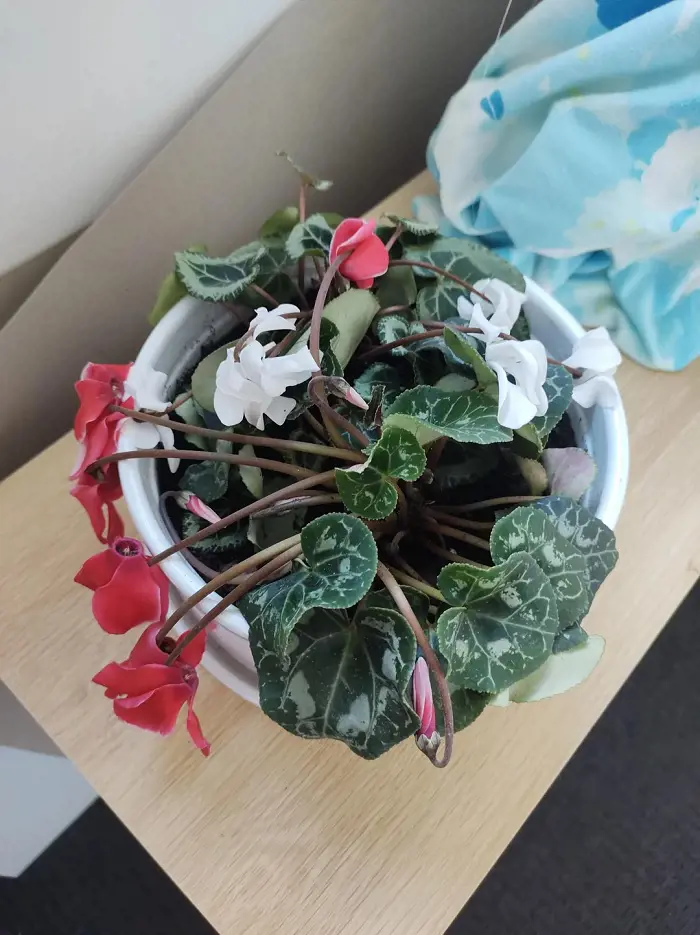
Effective pest and disease prevention is crucial for maintaining the vitality of cyclamen plants. Regularly inspect the leaves, stems, and soil for signs of pests like aphids, spider mites, or fungal infections. Keep the environment well-ventilated and avoid overwatering.
Applying neem oil or insecticidal soap can deter common pests. Quarantine new plants before introducing them to prevent potential infestations. Remove any damaged / diseased foliage quickly and dispose of it properly.
Moreover, maintaining optimal growing conditions, such as proper watering and suitable temperatures, strengthens the plant's natural defenses.
Finding Your Perfect Cyclamen

Selecting the ideal cyclamen variety involves considering factors that align with your preferences and care capabilities.
Start by assessing your space: Mini cyclamens are perfect for smaller areas, while larger varieties make a statement in spacious gardens.
Pay attention to color preferences, as cyclamens come in an array of shades, allowing you to personalize your green space. Moreover, consider the plant's hardiness and climate compatibility to ensure it thrives in your specific conditions.
Whether you go for Cyclamen persicum for indoor elegance or Cyclamen hederifolium for outdoor charm, choosing the right cyclamen offers a rewarding and visually appealing addition to your plant collection.






